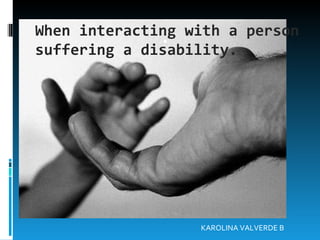when interacting with a person suffering a disability
- 1. When interacting with a person suffering a disability. . KAROLINA VALVERDE B
- 2. * When speaking, do not use nicknames to refer to them. * Treat them with kindness and respect always.
- 3. * If the disabled person has trouble walking, accompany them at their own pace. * If you use crutches or a cane, take care that other people do not stumble .
- 4. * In use, ensures that their crutches or a cane has always near. * When getting off a means of transport, do not touch your cane or crutches.
- 5. If the disabled person using a wheelchair, ask if you need assistance and how you can help. Avoid sudden movements that may make you fall of your chair.
- 6. By helping a person in a wheelchair, be careful when descending curbs and whenever there is a recess. * Never take the chair arms.
- 7. If possible, to help a person in a wheelchair, sit down to talk. * Given a blind or low vision, ask if you can help only if you see flickering or against an obstacle.
- 8. * If the blind person wants to cross a street, offer your arm. Never take it. * If the blind person needs to board a conveyance or a ladder, take your hand and support it on the banister or handrail.
- 9. In explaining to a blind person a direction, if possible, accompany to the place you want. Do not you tell by signs or nods. Though you can see, have them always the word and look into his eyes.
- 10. * If the person is mentally retarded, never talk about it as if it were in front. * If the person is deaf or hypo accused, speak slowly and looking into his eyes so that you can read your lips.
- 11. * Do not yell, be clear and concise. Use simple words. If you do not understand, write it down. * Be patient.
- 12. THE END











